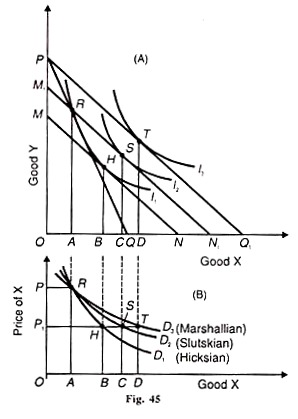The below mentioned article provides an overview on the Compensated Demand Curve.
The compensated demand curve shows the quantity of a good which a consumer would buy if he is income-compensated for a change in the price of that good. In other words, the compensated demand curve for a good is a curve that shows how much quantity would be purchased at the changed price by the consumer if the income effect is eliminated.
The compensated demand curve can be explained in terms of both the Hicks and Slutsky approaches to the substitution effect. The two-storey Figure 45(A) illustrates the construction of the Hicks and Slutsky compensated demand curves and the uncompensated (or ordinary or Marshallian) demand curve.
The upper portion of the figure shows the substitution effects of the Hicks and Slutsky analyses and the combined price effect.
The lower portion of the figure shows the derivation of the Hicks and Slutsky compensated demand curves and the ordinary demand curve. First consider the lower diagram (B) where the price of good X is taken on the vertical axis. Point P is an arbitrary point on this axis which shows the price of X when the budget line is PQ in the upper diagram. The fall in the price of X as shown by the budget line PQ1 is reflected in point P1 in the lower diagram.
The Marshallian Uncompensated Demand Curve:
First we explain the derivation of the Marshallian uncompensated demand curve. Suppose the initial equilibrium of the consumer is at point R where the budget line PQ is tangent to the indifference curve I1, and OA of good X is bought by the consumer in the tipper diagram.
Let the price of X fall. As a result, the budget line PQ extends to PQ3 and the consumer is at a higher point of equilibrium T on the indifference curve I3 .The movement from R to T is the price effect which includes both the substitution effect and the income effect. This is shown by the D3 curve in the lower portion of the figure. This is the uncompensated (or ordinary or Marshallian) demand curve which shows that when the price of good X falls from P to P1 its quantity demanded increases from OA to OD.
ADVERTISEMENTS:
The Hicksian Compensated Demand Curve:
Since the compensated demand curve is based on the substitution effect of a change in the price of good X, we carry the above analysis further and derive the Hicks substitution effect. Let us take away the increase in the real income of the consumer due to the fall in the price of X equal to PM of good Y and Q1 N of X good by drawing a compensated budget line MN parallel to the budget line PQ1.
This line MN is tangent to the original indifference curve I1, at point H. The movement from point R to H on the I1, curve is the substitution effect which traces out the demand curve D1, in the lower portion of the figure when the demand for X increases from OA to OB with the fall in its price from P to P1.
The Slutsky Compensated Demand Curve:
ADVERTISEMENTS:
In order to derive the Slutsky substitution effect, let us take away the increase in the apparent real income of the consumer equal to PMX of Y and Q1N1 of X by drawing the Slutsky compensated budget line M1N1, parallel to PQ which passes through the original point R on the I1, curve where he will buy the same quantity OA of X. But since the price of X has fallen, he will buy more of it so that he moves to point S on the higher indifference curve I2, which is tangent to the budget line M1N1 Thus the movement from R to S traces out the Slutsky compensated demand curve D2 in the lower part of the figure.
This curve shows that with the fall in the price of good X from P to P1 its demand increases from OA to ОС.
Conclusion:
A perusal of the compensated demand curve D1 of Hicks and D2 of Slutsky shows that the curve D2 is more elastic than D1 .This is because the total expenditure on the purchase of good X is greater in the Slutsky approach than in the Hicks approach. While the conventional demand curves D3 is more elastic than even the Slutsky demand curve D2.
Another important point to be noted is that the compensated demand curve, whether of Hicks or Slutsky, always slopes downward because it is so drawn that the substitution effect only is in operation and the income effect is altogether eliminated through compensating variation in income. But the ordinary demand curve may or may not slope downward. In the case of the ordinary demand curve like D, both the substitution and income effects are in operation and they explain the downward slope of the curve.
In case X is an inferior good, the ordinary demand curve will slope downward but will be elastic than the compensated demand curves D1 and D2 because the substitution effect is stronger than the income effect in the case of the ordinary demand curve. But if X happens to be a Giffen good, the ordinary demand curve will slope from left to right upward i.e. it will have a positive slope because the income effect is stronger than the substitution effect. On the other hand, the compensated demand curves will have a negative slope because they are not affected by the income effect.
